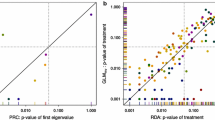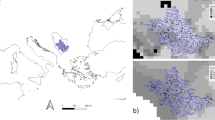Abstract
The identification of the effects of toxicants on biological communities is hampered by the complexity and variability of communities. To overcome these challenges, the trait-based SPEAR approach has been developed. This approach is based on (i) identifying the vulnerable taxa using traits and (ii) aggregating these taxa into a group to reduce the between-replicate differences and scattered low-abundance distribution, both of which are typical for biological communities. This approach allows for reduction of the noise and determination of the effects of toxicants at low concentrations in both field and mesocosm studies. However, there is a need to quantitatively investigate its potential for mesocosm data evaluations and application in the ecological risk assessment of toxicants. In the present study, we analysed how the aggregation of the sensitive taxa can facilitate the identification of the effects. We used empirical data from a long-term mesocosm experiment with stream invertebrates and an insecticide as well as a series of simulated datasets characterised by different degrees of data matrix saturation (corresponding to different sampling efforts), numbers of replicates, and between-replicate differences. The analyses of both the empirical and simulated data sets revealed that the taxa aggregation approach allows for the detection of effects at a lower saturation of the data matrices, smaller number of replicates, and higher between-replicate differences when compared to the multivariate statistical method redundancy analysis. These improvements lead to a higher sensitivity of the analysed systems, as long-term effects were detected at lower concentrations (up to 1,000 times). These outcomes suggest that methods based on taxa aggregation have a strong potential for use in mesocosm data evaluations because mesocosm studies are usually poorly replicated, have high between-replicate variability, and cannot be exhaustively sampled due to technical and financial constraints.




Similar content being viewed by others
References
Beketov MA, Liess M (2008a) An indicator for effects of organic toxicants on lotic invertebrate communities: Independence of confounding environmental factors over an extensive river continuum. Environ Pollut 156(3):980–987. doi:10.1016/j.envpol.2008.05.005
Beketov MA, Liess M (2008b) Variability of pesticide exposure in a stream mesocosm system: macrophyte-dominated vs. non-vegetated sections. Environ Pollut 156(3):1364–1367. doi:10.1016/j.envpol.2008.08.014
Beketov MA, Liess M (2008c) Acute and delayed effects of the neonicotinoid insecticide thiacloprid on seven freshwater arthropods. Environ Toxicol Chem 27(2):461–470. doi:10.1897/07-322r.1
Beketov MA, Schafer RB, Marwitz A, Paschke A, Liess M (2008) Long-term stream invertebrate community alterations induced by the insecticide thiacloprid: effect concentrations and recovery dynamics. Sci Total Environ 405(1–3):96–108. doi:10.1016/j.scitotenv.2008.07.001
Beketov MA, Foit K, Schafer RB, Schriever CA, Sacchi A, Capri E, Biggs J, Wells C, Liess M (2009) SPEAR indicates pesticide effects in streams—comparative use of species- and family-level biomonitoring data. Environ Pollut 157(6):1841–1848. doi:10.1016/j.envpol.2009.01.021
Beketov MA, Kefford BJ, Schafer RB, Liess M (2013) Pesticides reduce regional biodiversity of stream invertebrates. Proc Natl Acad Sci USA 110(27):11039–11043. doi:10.1073/pnas.1305618110
Campbell PJ, Arnold DJS, Brock TCM, Grandy NJ, Heger W, Heimbach F (1999) Guidance document on higher-tier aquatic risk assessment for pesticides (HARAP). SETAC Press, Brussels
De Jong FMW, Brock TCM, Foekema EM, Leeuwangh P (2008) Guidance for summarizing and evaluating aquatic micro- and mesocosm studies, RIVM Report 601506009/2008. A guidance document of the Dutch platform for the Assessment of Higher Tier Studies, RIVM, Bilthoven
EFSA, European Food Safety Authority (2013) Guidance on tiered risk assessment for plant protection products for aquatic organisms in edge-of-field surface waters. EFSA J 11(7):3290
European Commission (2009) European Commission Directive 2009/128/EC of the European Parliament and of the Council of 21 October 2009 establishing a framework for Community action to achieve the sustainable use of pesticides, EU
Fleeger JW, Carman KR, Nisbet RM (2003) Indirect effects of contaminants in aquatic ecosystems. Sci Total Environ 317(1–3):207–233. doi:10.1016/s0048-9697(03)00141-4
Giddings JM, Brock TCM, Heger W, Heimbach F, Maund SJ, Norman SM (2002) Community-level aquatic system studies, interpretation criteria (CLASSIC). SETAC Press, Pensacola
Knauer K, Maise S, Thoma G, Hommen U, Gonzalez-Valero J (2005) Long-term variability of zooplankton populations in aquatic mesocosms. Environ Toxicol Chem 24(5):1182–1189. doi:10.1897/04-010r.1
Knillmann S, Stampfli NC, Noskov YA, Beketov MA, Liess M (2012) Interspecific competition delays recovery of Daphnia spp. populations from pesticide stress. Ecotoxicology 21(4):1039–1049. doi:10.1007/s10646-012-0857-8
Leps J, Smilauer P (2003) Multivariate analysis of ecological data using CANOCO. University Press, Cambridge
Liess M, Beketov M (2011) Traits and stress: keys to identify community effects of low levels of toxicants in test systems. Ecotoxicology 20(6):1328–1340. doi:10.1007/s10646-011-0689-y
Liess M, Beketov MA (2012) Rebuttal related to “Traits and stress: keys to identify community effects of low levels of toxicants in test systems” by Liess and Beketov (2011). Ecotoxicology 21(2):300–303. doi:10.1007/s10646-011-0840-9
Liess M, von der Ohe PC (2005) Analyzing effects of pesticides on invertebrate communities in streams. Environ Toxicol Chem 24(4):954–965. doi:10.1897/03-652.1
Liess M, Schulz R, Liess MHD, Rother B, Kreuzig R (1999) Determination of insecticide contamination in agricultural headwater streams. Water Res 33(1):239–247. doi:10.1016/s0043-1354(98)00174-2
Newman MC, Unger MA (2002) Fundamentals of ecotoxicology. CRC Press, Boca Raton
Oksanen J, Blanchet FG, Kindt R, Legendre P, Minchin PR, O’Hara RB, Simpson GL, Solymos P, Stevens MH, Wagner H (2012). Vegan: Community Ecology Package. R package version 2.0-5. http://vegan.r-forge.r-project.org/
Sanderson H, Laird B, Brain R, Wilson CJ, Solomon KR (2009) Detectability of fifteen aquatic micro/mesocosms. Ecotoxicology 18(7):838–845. doi:10.1007/s10646-009-0327-0
Schäfer RB, Kefford B, Metzeling L, Liess M, Burgert S, Marchant R, Pettigrove V, Goonan P, Nugegoda D (2011) A trait database of stream invertebrates for the ecological risk assessment of single and combined effects of salinity and pesticides in South-East Australia. Sci Total Environ 409(11):2055–2063. doi:10.1016/j.scitotenv.2011.01.053
Schäfer RB, von der Ohe PC, Rasmussen J, Kefford BJ, Beketov MA, Schulz R, Liess M (2012) Thresholds for the effects of pesticides on invertebrate communities and leaf breakdown in stream ecosystems. Environ Sci Technol 46(9):5134–5142. doi:10.1021/es2039882
Stampfli NC, Knillmann S, Liess M, Beketov MA (2011) Environmental context determines community sensitivity of freshwater zooplankton to a pesticide. Aquat Toxicol 104(1–2):116–124. doi:10.1016/j.aquatox.2011.04.004
Stampfli NC, Knillmann S, Liess M, Noskov YA, Schafer RB, Beketov MA (2013) Two stressors and a community—effects of hydrological disturbance and a toxicant on freshwater zooplankton. Aquat Toxicol 127:9–20. doi:10.1016/j.aquatox.2012.09.003
The R Development Core Team (2010) R: a language and environment for statistical computing. Reference index version 2.15.2., Vienna, Austria. www.r-project.org
Van den Brink PJ, Ter Braak CJF (1999) Principal response curves: analysis of time-dependent multivariate responses of biological community to stress. Environ Toxicol Chem 18(2):138–148. doi:10.1897/1551-5028(1999)018<0138:prcaot>2.3.co;2
Van den Brink PJ, Ter Braak CJF (2012) Response to “traits and stress: keys to identify community effects of low levels of toxicants in test systems” by Liess and Beketov 2011. Ecotoxicology 21(2):297–299. doi:10.1007/s10646-011-0825-8
Van den Brink PJ, Hartgers EM, Fettweis U, Crum SJH, van Donk E, Brock TCM (1997) Sensitivity of macrophyte-dominated freshwater microcosms to chronic levels of the herbicide linuron. I Primary producers. Ecotoxicol Environ Saf 38:13–24
Van Wijngaarden RPA, Brock TCM, Van den Brink PJ (2005) Threshold levels for effects of insecticides in freshwater ecosystems: a review. Ecotoxicology 14(3):355–380. doi:10.1007/s10646-004-6371-x
Wang M, Riffel M (2011) Making the right conclusions based on wrong results and small sample sizes: Interpretation of statistical tests in ecotoxicology. Ecotoxicol Environ Saf 74(4):684–692. doi:10.1016/j.ecoenv.2010.10.019
Acknowledgments
The study was supported by the European Union (Project INTERACT, Marie Curie IIF contract no. MIF1- CT-2006-021860) and the Helmholtz Association of German Research Centres (Project ECOLINK, HRJRG-025). We thank two anonymous reviewers for many constructive suggestions.
Conflict of interest
The authors declare that they have no conflict of interest.
Author information
Authors and Affiliations
Corresponding author
Electronic supplementary material
Below is the link to the electronic supplementary material.
Rights and permissions
About this article
Cite this article
Beketov, M.A., Kattwinkel, M. & Liess, M. Statistics matter: data aggregation improves identification of community-level effects compared to a commonly used multivariate method. Ecotoxicology 22, 1516–1525 (2013). https://doi.org/10.1007/s10646-013-1138-x
Accepted:
Published:
Issue Date:
DOI: https://doi.org/10.1007/s10646-013-1138-x




